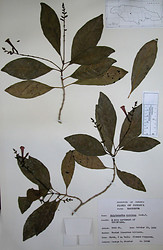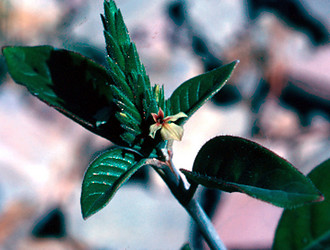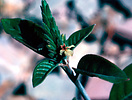Stenandrium Clade
Lucinda A. McDade and Carrie Kiel- Aphelandra verticillata Nees
- Holographis ehrenbergiana Nees
- Holographis pallida Leonard & Gentry
- Holographis velutifolia (House) T. F. Daniel
- Neriacanthus purdieanus Benth.
- Salpixantha coccinea Hook.
- Stenandrium mandioccanum Nees
- Stenandrium pilosulum (S. F. Blake) T. F. Daniel
Note: this taxon list is still under construction. It does not yet contain all known Stenandrium Clade subgroups.
Only species sampled by McDade et al. (2005) are included in the list above. There are additional New World species of Stenandrium and of Holographis that likely belong here as well. Note that phylogenetic work to date indicates that Old World plants that were treated as Stenandrium by Vollesen (1992) are part of a separate clade, here called the Stenandriopsis Clade. Also, McDade et al. (2005) included two other species of Neriacanthus; these were placed as part of the "Other New World Acantheae" Clade.
Introduction
The Stenandrium clade includes the New World genera Stenandrium and Holographis plus three surprises: the two Jamaican Acantheae, Salpixantha (with a single species) and Neriacanthus purdieanus (one of five species, the others occur in mainly South America and Panama) are part of the Stenandrium clade as is at least one species of Aphelandra, A. verticillata (so far as we know, the other species of Aphelandra are part of the "Other New World Acantheae" clade). Interestingly, so far as is known, plants belonging to this clade share a base chromosome number of 13 which appears to be a synapomorphy and distinguishes these plants from other New World Acantheae which (again, so far as is known) have x = 14. Chromosome numbers are not known for Salpixantha, N. purdieanus or A. verticillata but we predict x = 13 for these taxa. This clade is remarkable for its diversity of corolla morphologies, presumably associated with adaptation for different pollinators although empirical studies are few.
References
McDade, L. A., T. F. Daniel, C. A. Kiel, and K. Vollesen. 2005. Phylogenetic relatinships among Acantheae (Acanthaceae): Major lineages present contrasting patterns of molecular evolution and morphological differentiation. Systematic Botany 30: 834-862.
Vollesen, K. 1992. The Old World species of Stenandrium (Acanthaceae: Acantheae). Kew Bulletin 47: 169-202.
Title Illustrations

| Scientific Name | Salpixantha coccinea Hook. |
|---|---|
| Reference | British Museum (BM) |
| Specimen Condition | Dead Specimen |
| Collection | BM |
| Collector | George R. Procter 11046 |
| Copyright |
©

|
About This Page

Rancho Santa Ana Botanic Garden, Claremont, California, USA
Carrie Kiel

Rancho Santa Ana Botanic Garden
Correspondence regarding this page should be directed to Lucinda A. McDade at and Carrie Kiel at
Page copyright © 2006 and Carrie Kiel
All Rights Reserved.
- First online 13 September 2006
- Content changed 13 September 2006
Citing this page:
McDade, Lucinda A. and Carrie Kiel. 2006. Stenandrium Clade. Version 13 September 2006 (under construction). http://tolweb.org/Stenandrium_Clade/52322/2006.09.13 in The Tree of Life Web Project, http://tolweb.org/












 Go to quick links
Go to quick search
Go to navigation for this section of the ToL site
Go to detailed links for the ToL site
Go to quick links
Go to quick search
Go to navigation for this section of the ToL site
Go to detailed links for the ToL site